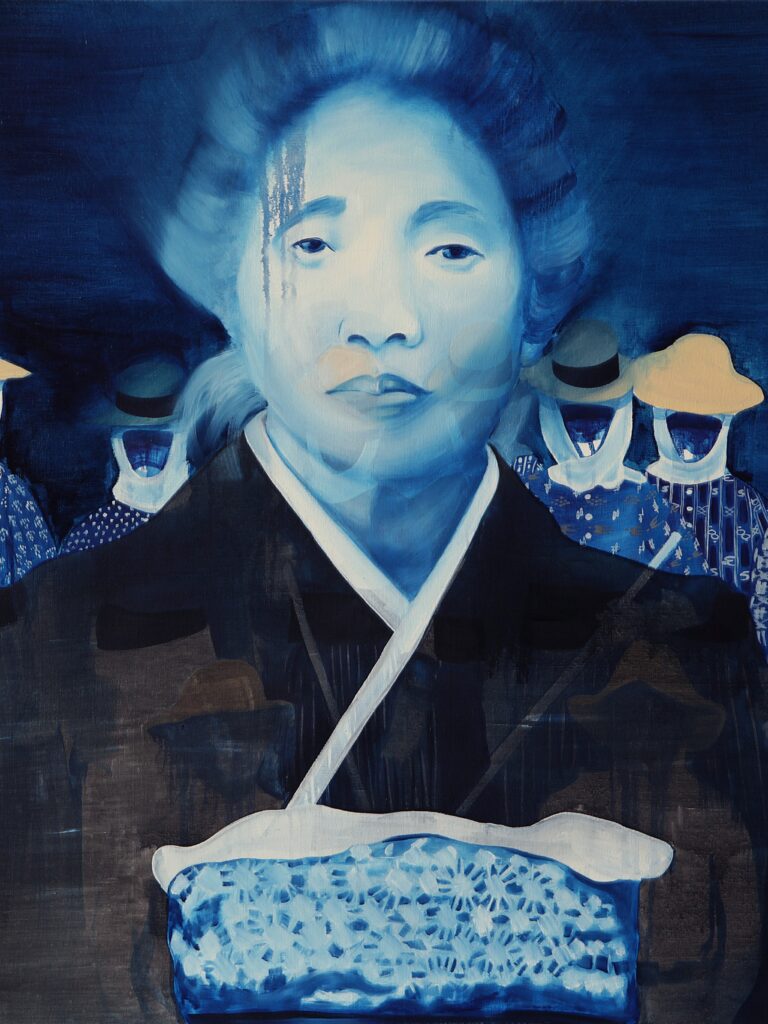

Laura Kina is a Yonsei mixed-race Uchinanchu artist and professor at the Art School at DePaul University in Chicago, Illinois and received her MFA in Studio Art from the University of Illinois at Chicago [1]. Her artwork is deeply entwined with her mixed-race identity and her ancestral roots in Hawai’i as an Uchinanchu, and her creations have been exhibited across the United States and in Japan.
Laura’s work addresses body politics, Asian American and mixed-race cultural identity, and its intersections with poignant family narratives in the Pacific through decolonizing mediums of expression.
In 1912, Laura’s family came to Hawai’i from Okinawa as part of settler-colonial sugarcane migration. Growing up in Seattle, Laura and her family were close friends with people from the Hawai’ian diasporic community. As part of discovering her heritage, Laura began researching oral histories in Hawai’i through speaking with elders and spearheaded a study abroad program where she took students to Okinawa. Laura names this decade-long journey as a “conscious process” that began from her reading of the ethnographic book Uchinanchu: A History of Okinawans in Hawaii from the University of Hawai’i at Manoa that led her to her work on diaspora, mixedness, and showcasing forgotten family stories through art.
In 2015, Laura’s paintings were featured in the Los Angeles-based Japanese American National Museum’s “Sugar/Islands: Finding Okinawa in Hawai’i – the Art of Laura Kina and Emily Hanako Momohara” exhibit examining diasporic labour migration and settlement from Okinawa to Hawai’i in the late 19th and 20th centuries [2]. Her indigo Sugar paintings in the “Sugar/Islands” exhibit concentrated on women’s labour, with palettes inspired by the colours of the kasuri (fabric woven with dyed fibres to create patterns) kimonos worn by female Okinawan immigrant workers to protect themselves from the sun. The exhibition was only the second time in the 40-year history of the museum to display Okinawan work, with renowned Okinawan American sculptor Toshiko Takaezu being the first.

Laura remarked on how the artistic presence of her work was felt by the community: “I didn’t really know how much it was going to impact the community there, but it was wonderful; all kinds of supplemental activities, the family day, and seeing the Okinawan community come into the museum because before [the exhibit], it’s not really a space they related to as their history.” In preparing for the exhibit, Laura returned to Hawai’i and Okinawa with her father to research their family history, as well as noting the lost “ghost stories” of her community.
“The project is really pushing back against white normative standards of beauty, but also Japanese standards of beauty. It is also a language revitalization project…”
Laura Kina
Laura illustrated the 2019 book Okinawan Princess: Da Legend of Hajichi Tattoos in collaboration with author Lee Tonouchi, originally written in Pidgin English and translated into Japanese and Uchinaguchi. The book tells the history of hajichi (an Okinawan female tattooing tradition) and the legend of a high priestess during the Ryukyu Kingdom and adapts it for contemporary times: “The project is really pushing back against white normative standards of beauty, but also Japanese standards of beauty. It is also a language revitalization project, both in terms of valuing Pidgin and valuing Uchinaguchi not as a dialect of Japanese but as [one of languages of the Ryukyu Islands while] also telling this feminist history of hajichi tattoos.”

https://www.laurakina.com/artwork-archive/uchinanchu-2015-2016/
The book reframes Okinawan identity as Indigenous, a radical act as part of “this larger push to change the way we understand Okinawa and also our alliances and allegiances as well … It is remembering, but it is also bringing stories to life in a new way for today.” Cultural activist projects such as Okinawan Princess brings critical conversations around Indigenous solidarities, decolonization, and the continuing militarization of the islands of Okinawa and Hawai’i to the forefront.
Laura’s current projects include her series titled Holding On, featuring “sacred, WWII memorial, and present-day military occupied sites in Okinawa, Japan and explores memory and affect through the genre of landscape painting.”Another major work is her Uchinanchu project comprised of textile-based paintings in which Laura considers her “proximity and distance to Asian American, white, Okinawan diaspora, and indigenous identities and communities” as a mixed race, Yonsei, Uchinanchu.
Laura embodies building community and friendships in her artistic ethos, and her exploration of her Indigenous Uchinanchu identity through visual storytelling is crucial for broader Asian American decolonization narratives. Laura’s breast cancer diagnosis in June 2020 has shaped her experience of the COVID-19 pandemic and beyond. It lead her to document her journey through Youtube videos; a new series of paintings and photographs titled “Over the Rainbow, One More Time;” and a poignant short story titled “Second City, 2nd Shot” about her quest to receive the COVID-19 vaccine. The beautiful ending of the piece aligns with Laura’s larger body of work and the depth of her dedication to her community where she asks: “Can I think beyond my body? Can I feel beyond my city? Can I see beyond islands? Can I dream beyond nation states? And still be here.”
Key Themes: Indigeneity, decolonization, migration, women’s history, family narratives
Interview conducted by Shō Tanaka on July 25th, 2018.
Check Out Laura’s Website Here
—
References
[1] About. Laurakina.com. (n.d.). https://www.laurakina.com/about/
[2] Japanese American National Museum, “Sugar/Islands: About the Exhibition.” http://www.janm.org/exhibits/sugar-islands/
